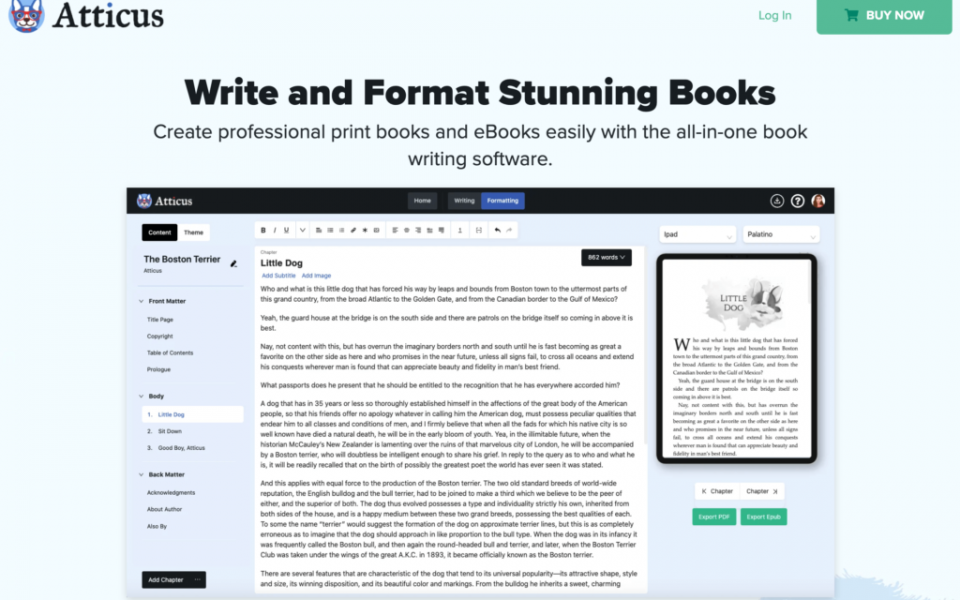Atticus.io Review: A Review of Dave Chesson’s Book Formatting Software
In working with thousands of authors over the years, the one bottleneck (and fear) of book production is the formatting piece of the project.
Why formatting? It’s the one area most indie authors get hung up on when it comes to the tech side of the business. Most authors—that have never used Adobe InDesign—have conceptualized a belief about book formatting that it’s an area that should only be approached by professional formatters. Although this is true in big-name publishing houses, when it comes to Indie publishing, it’s up to the author to either:
- Do the task themselves, or
- Outsource the project to a professional.
Most authors I know will outsource it for a few hundred dollars—or less—to a Fiverr freelancer, or go through a formatting company that charges exorbitant amounts of cash for a two-hour job. Yes, if you have a book that is averaging about 40,000 words, it should only take you a couple of hours to format this for uploading to Kindle. It sounds easy, and in truth, it is, but as the authors of our own stories, separating the tech from the creativity can be challenging.
The bottom line is, even IF you are good at formatting, it’s the last thing most authors want to be working on, with clunky text files and the details required that goes into formatting even a simple book.
Until now.
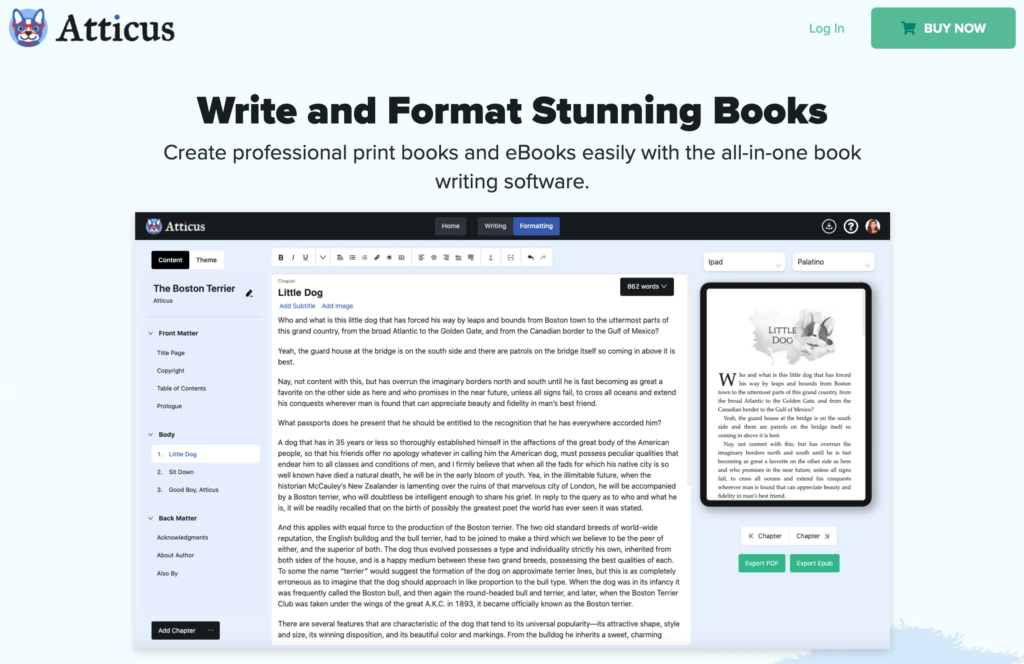
With the launch of Atticus.io, the new writing, editing and book formatting software launched by Dave Chesson and his development team, formatting is no longer the cumbersome task that it has been up to now. In fact, with zero experience around formatting, you can now easily write, organize, format and export your publishable files in various formats to be published across multiple platforms.
Sounds too good to be true?
In the rest of this post, we will walk you through a review of the Atticus.io software. By the time we are done, even for the most resistant of non formatters, you will be leaning towards doing this on your own, saving you lots of money on expensive formatting gigs as you wait days or weeks for the job to be completed. With Atticus, you can have your book formatted and ready to publish within thirty minutes or less. In fact, after working with this for a couple of projects, I had it down to about eleven minutes for a completely published book, and I’m sure that time can be beaten.
We want you to make informed decisions when it comes to how and where to invest your money. That’s why our mission is to help educate authors on the various self-publishing companies and services that are on the market today.
Our reviews are meant to be unbiased, 3rd party reviews, but we will speak up if there is a scam or a clearly better option.
In this review of Dave Chesson’s book formatting software, you will learn:
Book Formatting Options
When Vellum came onto the scene, it made formatting easier and most authors can get a book formatted in less than 30 minutes with some practice. But as good as it is/was, Vellum lacked many features that authors needed, and, taking into account the cost of this tool—$249 for both eBook and Print—it is an expensive buy, especially if you only plan to do one book and never use it again.
Another shortcoming of Vellum is that it only works with Mac, and it has a lot of features that are still missing with little progress to show for future development. See our full Vellum Review here.
Then, Kindle Direct Publishing (KDP) launched Kindle Create, a free formatting tool to support authors with publishing. Although it’s a great free option compared to Vellum, it is set up for publishing to KDP and the formatting won’t always work across other platforms such as Draft2Digital.
The other formatting options are Kindle Create or Reedsy Book Editor. Although these tools can do the job, the experience is diluted when put to the test against Atticus.
Enter Atticus.
What is Atticus?
As Dave Chesson has said, “When describing Atticus, I like to tell people, ‘If Scrivener, Google Docs, and Vellum got together and had a baby, its name would be Atticus.”
Atticus is a book formatting software that allows authors to write, format, and export beautiful and professional ebooks and books. It works on all computers and across multiple devices (not just Mac, as Vellum does), it is cheaper ($147) and provides writers with a central hub to set goals, collaborate on projects and save projects to Cloud. In other words, it has everything you have ever wanted in three separate software—Vellum, Scrivener and Google Docs—but is located in one place. Also, it has amazing support from the Atticus Development team.
And that is what we will be discussing here in this content. I’m not here to convince you why you should be using Atticus, but by the time we are through, you will be asking yourself why you want to continue using anything else to write, plot, plan or format your book.
As of now, Atticus is currently both a word processor and a book formatting software. You can write, edit, and export your book, novel, or memoir without getting pulled into the tech side of things. Atticus is all about making life easier for authors and teams.
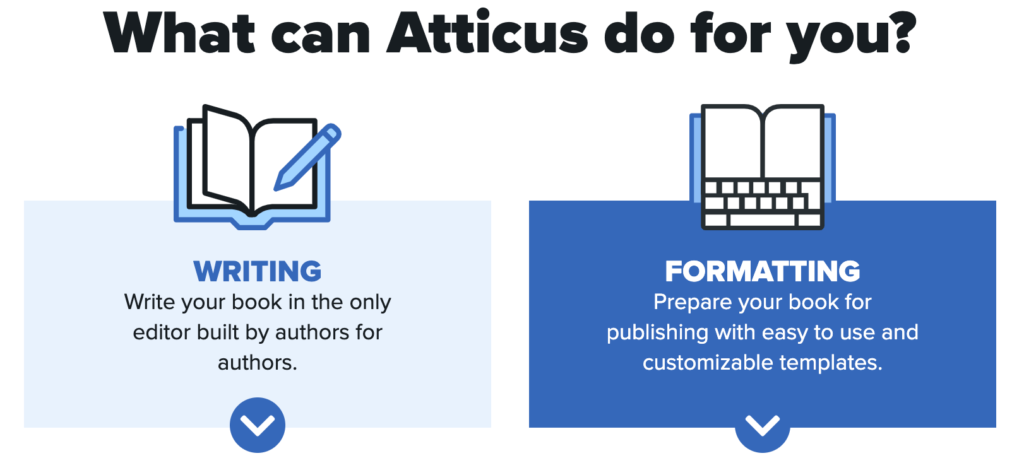
PRO Features
We can spend a lot of time on this section, but as Atticus is in a constant state of growth and development, we will give you the core features and allow you to explore from there.
Here are the features that make Atticus the most robust, fluent, aesthetic and helpful book writing software on the market today. And it’s only just started. Here’s why…
With Atticus, you can:
- Format the book and export to ebook or print, to use in KDP, IngramSpark, Draft2Digital, or wherever you sell your books.
- Create chapters immediately and begin writing.
- Drag and drop chapters or sections (just like you can in Scrivener) and are offered an abundance of writing tools
- And a lot more features…
Cross Platform Use
Perhaps the most powerful feature of Atticus.io is its ability to be easily transferable across platforms. This is a feature that Vellum could never integrate into its platform. And now it doesn’t have to. With Atticus, on the other hand, it’s available not just for Mac, but for Windows, Linux, Chromebooks, as well as in your Internet browser.
When you consider that Mac users make up only 5% of the market share (another 4% owned by Linux and other operating systems) why would Vellum cut out such a large market? Who knows, and now, it doesn’t matter. Atticus works across all these platforms.
Auto Save Backups
I have lost backup material with other software before. If this ever happened to you, then you know what it feels like to lose all that material you spent days and weeks compiling. But with Atticus.io, the software saves it to the cloud online and offline. You write and format, and it does the rest without any additional steps required.
You don’t have to worry about losing all that hard work because of a power glitch. You can backup all your books one at a time, or all at once, without any hassle or break in your writing flow.
Intuitive and User Friendly
Dave Chesson and his team are all about creating tools that are user-friendly and integrate with other apps, cloud storage, and bring your writing world to life through collaboration with technology. This means you get software that takes care of everything you need.
The app is intuitive in how it navigates across systems, making your writing experience a seamless and fun experience. Yes, who would have thought that writing and formatting could be integrated as fun activities to do? But with Atticus.io, they actually are.
Integration with ProWritingAid
There are currently two top-end recommended software for grammar and spelling check: Pro Writing Aid and Grammarly. Currently, Atticus.io is planning to integrate with Pro Writing Aid as a way to eliminate a lot of the back and forth between various software required to check proof of a manuscript.
Grammarly may be a bigger challenge as it is not easily set up to integrate with other apps. But with ongoing upgrades to Atticus, anything is possible in the near future.
Built-in Theme Builder
This is one of the best features of Atticus.io, a variety of blended themes that matches any kind of book you are putting together. The theme builder allows you to create (and save) your own custom styles for your book. In addition, you can use a variety of pre-rendered versions. The theme builder is the big sell for this program, and it scales above what the other book formatting softwares are currently featuring.
There are more themes to come, but for now, the themes to choose from:
- Finch
- Minerva
- Penelope
- Clairmont
- Titus
- Delphini
- Aether
- Seraphina
- Watts
- Minax
- Delta
- Hughes
- Intratex
- Bonkers Books
- Atreides
- Scarlett
- Elinor
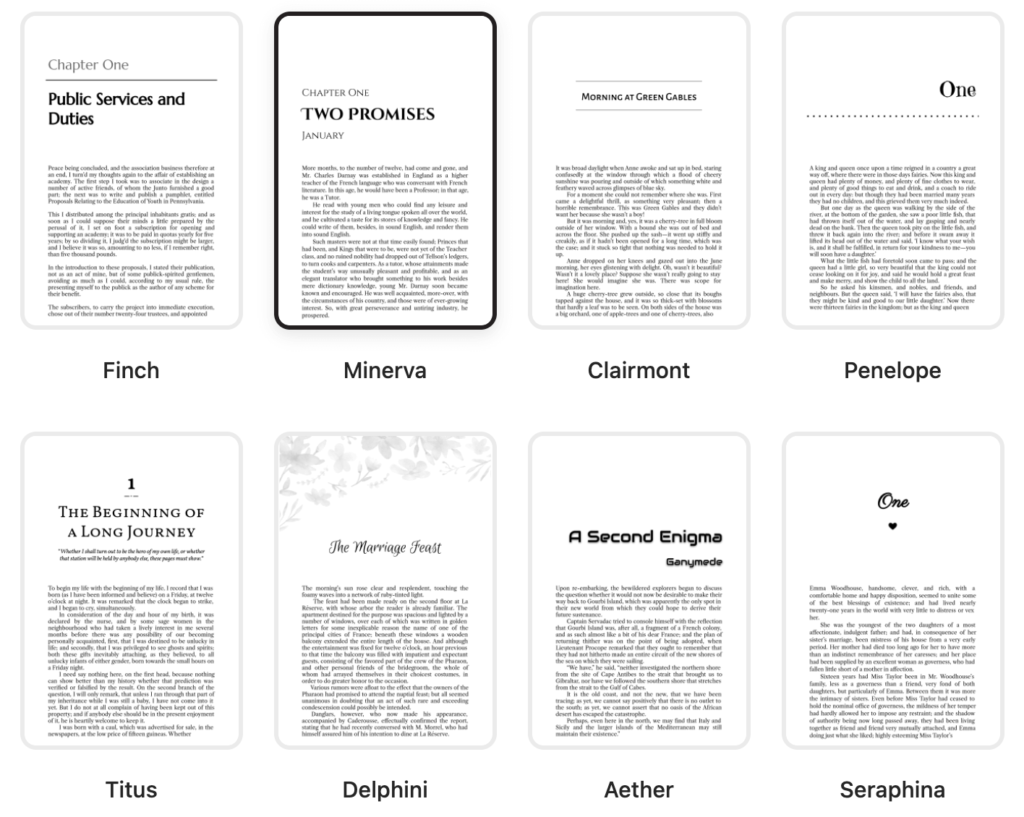
When ready to choose your theme, you can easily switch between themes to try out various formats and compare the look and feel until you align with the perfect match for your kind of book.
Importing / Exporting Feature
IMPORTING: You can easily import a current document from most formats. This is simple to do and is uploaded within 30 seconds or less. As of now, Atticus supports DOCX, MOBI, RTF, and EPUB file types for importing, with more options coming down the pipeline.

EXPORTING: Like Vellum, Atticus will export an EPUB-format eBook, as well as a PDF file for your paperback and/or hardcover.
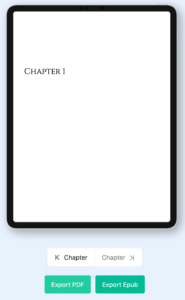
Word Counter
With Atticus, you can see your word count in three stages: By section, by chapter, or the complete book. All you do is toggle from chapter to book to section. Too easy.
Footnotes / Endnotes
Yes, this makes a relatively cumbersome task very easy with a built in tool for installing footnotes. Regardless if you are writing a nonfiction book, academic papers, textbook, or information book, all footnotes can be easily inserted.
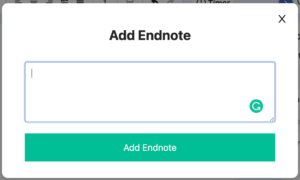
Multiple Device Previewer
This is a fantastic feature that allows your content to be viewed on 14+ devices. There is no other formatting tool that has this function built-in. You can get a really good view of how your book appears to readers depending on the device readers are using.
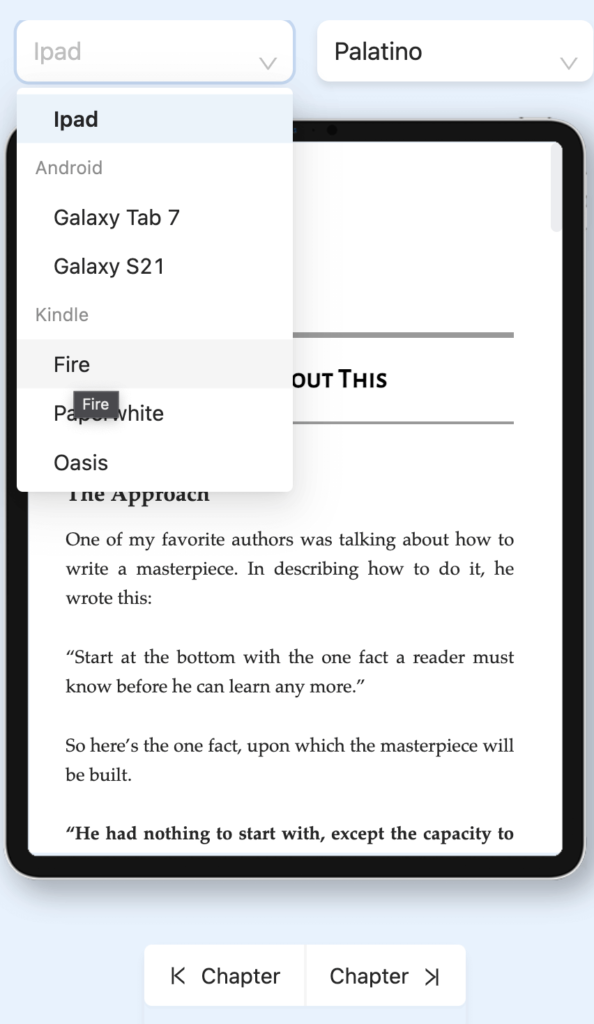
Writing Tools / Timer
Just like Google Docs capability, you can actually write your book in Atticus and it saves it to the cloud right away. This tool can take the place of your word doc software and can do what Scrivener was designed for…write and publish books.
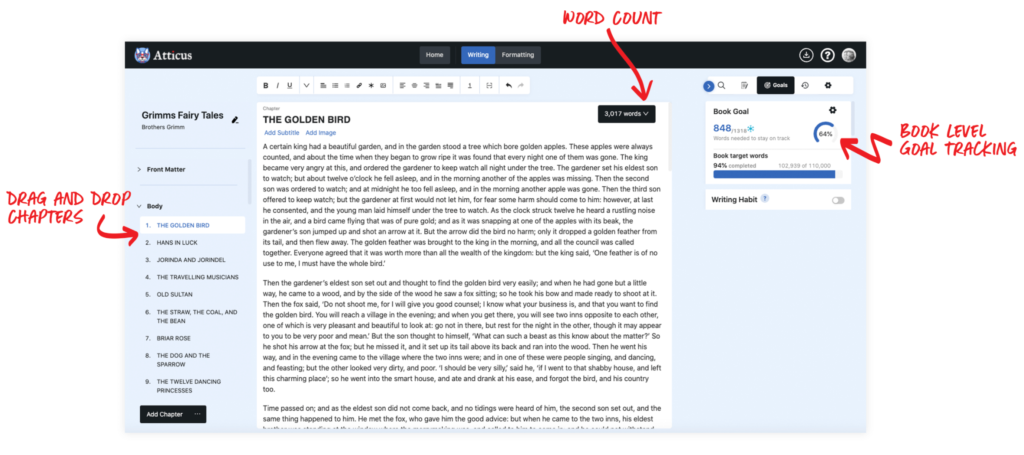
But one of my favorite features that goes with this is the timer that is installed to track your writing time. Yes, there is a “Sprint Timer” installed so that you can track your writing speed and take effective breaks after your writing session. Do you want access to a timer that is NOT on your phone but can let you know when it’s time to start and stop?
Since using this, it has accelerated my writing time.
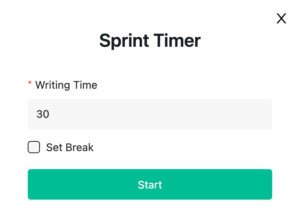
Front and Back Matter Elements
This is a massive time saver, having these elements already built in. No more cutting and pasting or saving templates. In fact, with Atticus, you can set up a template with the front and back matter so that, every time you set up a new book, the front and back matter is already there as part of your setup.
Project Grouping / Pen Name Categorizing
You can group your projects under one name that makes them easily accessible and organized. This works exceptionally well if creating a series of books that need to be housed under one project name.
If you have multiple pen names or are writing books in collaboration with other authors, you can create multiple author profiles to store all your projects under the author names pertaining to each book or series.
Book Goals and Writing Habit Feature
Now this is gold! A feature that lets you plug in your daily word count and writing goals to keep you on track with the project.
This also allows you to track your writing habit for the month. How does it work? Plug in how long your book project is, set the days you plan to write, and then when you hit save, it tells you the word count you must write on those days to hit your goal.
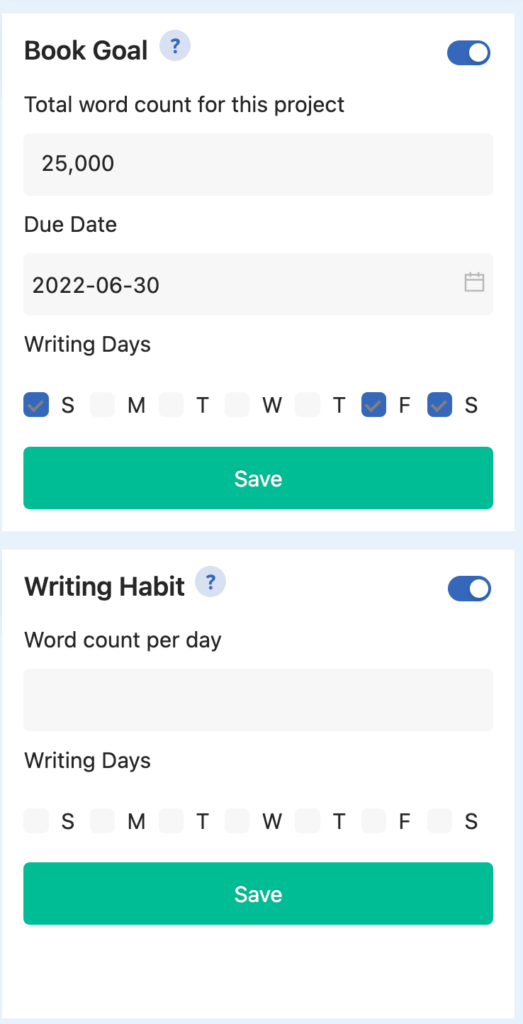
Large Print Options
If you’re not sure what this is, LPO (Large Print Option) is for readers that struggle with limited eyesight, and need the bigger text to be able to read. Yes, while audiobooks are certainly a viable option, for those that prefer reading to audiobooks, buying a copy of your favorite book in large print is the best choice. With Atticus, it allows you to easily convert your standard book version into a LPO book with just a few clicks.
Remember, this is a dynamic formatting tool and so that is what it is built for…to make your publishing experience seamless and fast. As LPO books must follow strict guidelines for publication, Atticus.io already takes all of this into consideration, pushing its capabilities beyond the competition.
Atticus Improvements and Upgrades
As with Dave Chesson’s Publisher Rocket, the upgrades to make the software the best on the market never ends. The same is to be said with Atticus.io.
The development team has a ton of improvements coming down the line and when you buy this at $147, you get all that inclusive with all future improvements. In fact, you can follow the roadmap of ongoing improvements here with the Atticus Roadmap.
Ongoing Tech Support
This is no surprise. The level of support that I have always experienced with Publisher Rocket certainly carries over to Atticus. In testing this software, I sent out ten emails with questions on usage, or clarity around how to best implement the integrated tools. Most emails had a response in under 6 hours, and the longest it took was no more than twelve. They even have a whole series of video tutorials to help you get started.
Formatting a Book With Atticus: How It Works
In this section, let’s walk through the steps to formatting and setting up a book using Atticus.io.
Beginning in the dashboard, you have the option to upload an existing book (in Word or other format) or, create a new book.
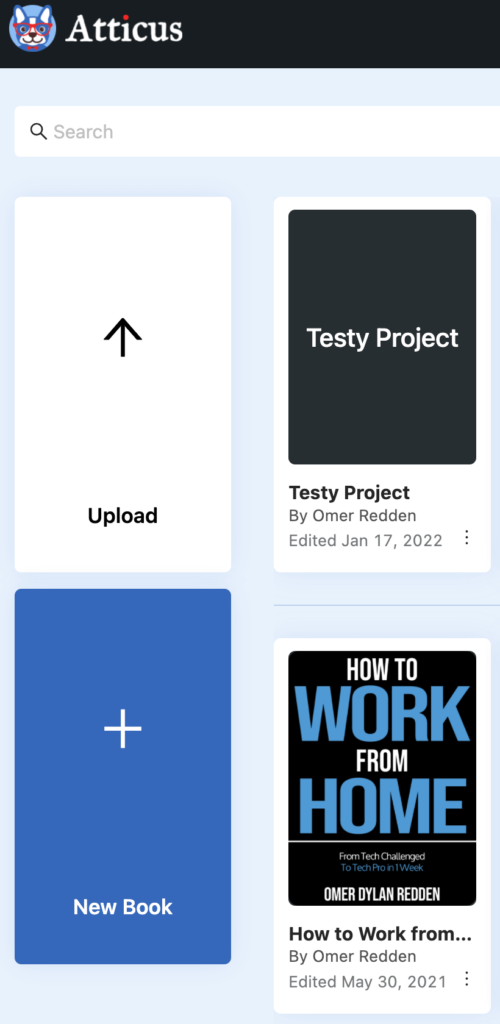
Now, you’re brought into the word processor element of the program, where you can create chapters and begin writing. You can drag and drop chapters or sections just like you can in Scrivener. But what I like about Atticus is the tools and features are easier to locate than in Scrivener. There is “less to look at” and this eliminates confusion and makes things better for setting up, moving chapters around, or just for writing.
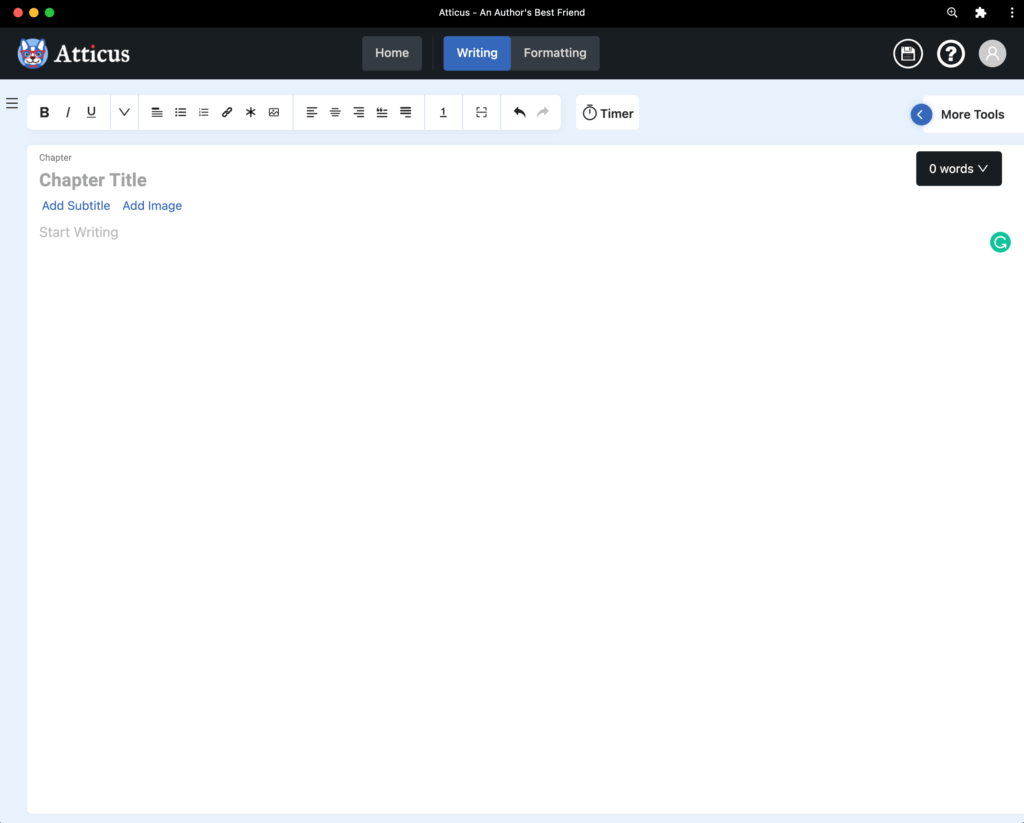
You then choose your theme (from 17 available), add your front and back matter, and presto…you can now download as a PDF or Mobi, or all of them.

You can also create your own custom theme if that is your preference.
Atticus sends the files to your email when ready.

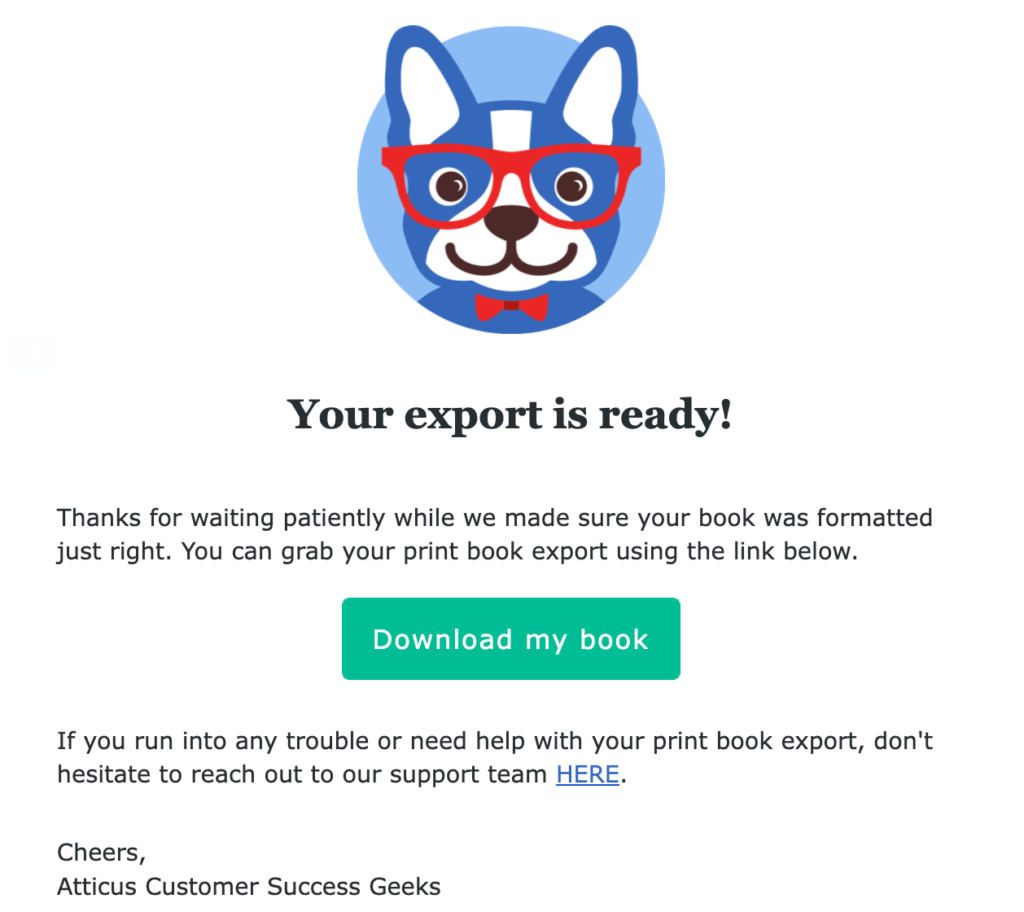
As Atticus is really just getting off the ground, there are more features, tools and additional ways to collaborate with other authors. Stay updated on the latest developments and enjoy formatting your book.
How Much Does It Cost?
This is the part that you won’t believe. Years ago I paid $247 USD for Vellum’s software. I found it basically easy to use but the functionality and features were limited. And they still are.
With Atticus, I paid $147 USD and when I started using it, I’ve never looked back. Yes, there are free tools out there that will let you format for free—Kindle Create and Reedsy Editor—but trust me, Free doesn’t even come close to what you get with Atticus. Not only the low price but, this includes all future editions, add-ons, and upgrades. Very cool.
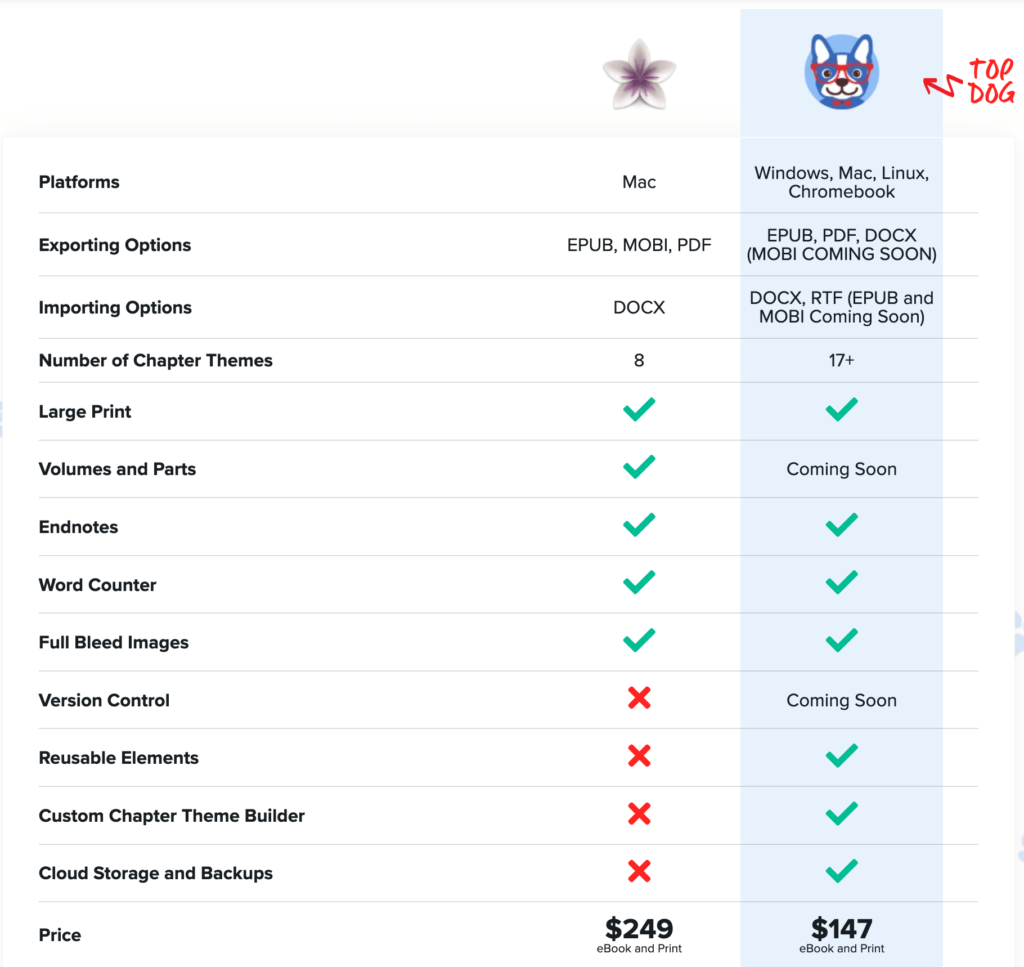
Final Thoughts on Atticus
The creator of the Atticus.io software is Dave Chesson, who is a well-known leader in the self-publishing community and online forums, leading the way with his quality-driven content on Kindlepreneur and his book marketing optimization tool, Publisher Rocket. (We have a review on that software, too.)
Atticus has definitely put the fun and joy into self publishing a book, not just at the publishing phase, but the complete journey. The software has just started up, and already it’s way beyond the capability of Vellum, and is moving towards all things Scrivener can do…and possibly more.
Atticus has a ton of pro features that make it the best up and coming formatting, writing and organizational tool in the market:
Pros
- Far more affordable, efficient and user-friendly than the current formatting options
- Works as a formatting software and as a word processor
- Available across multiple platforms
- Easy to use and trustworthy
- Contains all the major features of Vellum, many of Scrivener’s features, as well as Google Docs
- An amazing theme builder that lets you create the look you want
- A totally trustworthy and reliable support team
- Goal setting and tracking tools for establishing writing flow and focus
- AND, many more great features on the way!
Cons
- Uploading images into your manuscript can be finicky
- As a new program, it may have some bugs. These will become fewer as the program develops.
The ultimate vision (and goal) for Atticus is to become the last piece of writing, organization, plotting, and collaboration programming that you’ll ever need.
I’m looking forward to working with Atticus.io as part of my daily writing and publishing system.
If you have any questions or you want to share your experience with using the Atticus software, drop it below and we will be glad to help you out.
Ready to take the next step with your book idea? Learn the proven path in this book:

